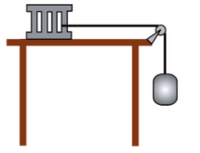
College Physics
11th Edition
ISBN: 9781305952300
Author: Raymond A. Serway, Chris Vuille
Publisher: Cengage Learning
expand_more
expand_more
format_list_bulleted
Concept explainers
Question
thumb_up100%
A 6.0-kg block rests on a smooth, frictionless table. A string attached to the block passes over a frictionless pulley, and a 5.0-kg mass hangs from the string, as shown in the figure below. What is the acceleration a? What is the tension 7 in the string?

Expert Solution
This question has been solved!
Explore an expertly crafted, step-by-step solution for a thorough understanding of key concepts.
This is a popular solution
Trending nowThis is a popular solution!
Step by stepSolved in 4 steps with 4 images

Knowledge Booster
Learn more about
Need a deep-dive on the concept behind this application? Look no further. Learn more about this topic, physics and related others by exploring similar questions and additional content below.Similar questions
- An orthodontist places 35 pounds of tension on the wire across your teeth.The insicor is just forward so that the wire is bent at 15 degrees on either side. a. What net force does the wire apply to the tooth? b. The tooth shifts and the ledt angle becomes 10 degrees while the right angle becomes 20 degrees. Assuming that the tension stays the same, what force is now applied to the tooth?arrow_forwardhow to solve?arrow_forward3. Two blocks A and B are connected by a rope and pulled with some force F along a frictionless horizontal surface, as shown. B a. Draw a free-body diagram for each block. b. Write Newton's second law for each block and obtain equations for the x and y directions. c. If the tension in the rope is given by T = F/3, find the ratio of the masses, ma/mg.arrow_forward
- A car of mass m=1000 kg starts moving from rest at a point Aon a smooth horizontal surface. The car moves under theaction of an engine force �⃗ of magnitude F=2000 N and ofdirection parallel to the surface. It reaches point O that is 70 maway from A, with a velocity �⃗!.a. Draw the free body diagram of the car.b. Using the Second Law of Newton, determine the acceleration of the car.c. Calculate the normal force acting on the car.d. Calculate the final velocity at O.arrow_forwardMr. Vollmayer pulls his children (21kg and 24kg) on a sled (5kg). The force of friction on the sled is 60N and he pulls horizontally with 65N. a. What is the normal force on the sled?b. What is the acceleration of the sled?c. How fast will they be moving in 60s if they started from rest?d. How far will they go in this time?arrow_forwardAn object is sliding down an incline as shown. a. Sketch the FBD of the box. b. State the action/reaction force pair for each force on your diagram.arrow_forward
- Researchers often use force plates to measure the forces that people exert against the floor during movement. A force plate works like a bathroom scale, but it keeps a record of how the reading changes with time. Shown is the data from a force plate as a woman jumps straight up and then lands.a. What was the vertical component of her acceleration during push-off?b. What was the vertical component of her acceleration while in the air?c. What was the vertical component of her acceleration during the landing?d. What was her speed as her feet left the force plate?e. How high did she jump?arrow_forwardA weight hangs on a frictionless pulley as shown in the figure.a.) What is the tension on the pulley strut?b.) What is the value of angle B?arrow_forwardwhile tom pushes a 40 kg box in horizontal direction along the classroom floor with a 100 N force, the box is moving in a straight line with constant speed of 0.5 m/s. Ignor air resistance when answering the questions below. a. Write down as much information as you can about the main horizontal forces exerted on the box ( names, directions and if enough information is given, numerical values). b. Write down as much information as you can about the main vertical forces exerted on the box (names, directions, and whenever possible, if enough information is given, numberical values). c. How far did the refrigerator move during those 3 seconds? Explain d. What was the refrigerator's acceleration during that time? Explainarrow_forward
arrow_back_ios
arrow_forward_ios
Recommended textbooks for you
 College PhysicsPhysicsISBN:9781305952300Author:Raymond A. Serway, Chris VuillePublisher:Cengage Learning
College PhysicsPhysicsISBN:9781305952300Author:Raymond A. Serway, Chris VuillePublisher:Cengage Learning University Physics (14th Edition)PhysicsISBN:9780133969290Author:Hugh D. Young, Roger A. FreedmanPublisher:PEARSON
University Physics (14th Edition)PhysicsISBN:9780133969290Author:Hugh D. Young, Roger A. FreedmanPublisher:PEARSON Introduction To Quantum MechanicsPhysicsISBN:9781107189638Author:Griffiths, David J., Schroeter, Darrell F.Publisher:Cambridge University Press
Introduction To Quantum MechanicsPhysicsISBN:9781107189638Author:Griffiths, David J., Schroeter, Darrell F.Publisher:Cambridge University Press Physics for Scientists and EngineersPhysicsISBN:9781337553278Author:Raymond A. Serway, John W. JewettPublisher:Cengage Learning
Physics for Scientists and EngineersPhysicsISBN:9781337553278Author:Raymond A. Serway, John W. JewettPublisher:Cengage Learning Lecture- Tutorials for Introductory AstronomyPhysicsISBN:9780321820464Author:Edward E. Prather, Tim P. Slater, Jeff P. Adams, Gina BrissendenPublisher:Addison-Wesley
Lecture- Tutorials for Introductory AstronomyPhysicsISBN:9780321820464Author:Edward E. Prather, Tim P. Slater, Jeff P. Adams, Gina BrissendenPublisher:Addison-Wesley College Physics: A Strategic Approach (4th Editio...PhysicsISBN:9780134609034Author:Randall D. Knight (Professor Emeritus), Brian Jones, Stuart FieldPublisher:PEARSON
College Physics: A Strategic Approach (4th Editio...PhysicsISBN:9780134609034Author:Randall D. Knight (Professor Emeritus), Brian Jones, Stuart FieldPublisher:PEARSON

College Physics
Physics
ISBN:9781305952300
Author:Raymond A. Serway, Chris Vuille
Publisher:Cengage Learning

University Physics (14th Edition)
Physics
ISBN:9780133969290
Author:Hugh D. Young, Roger A. Freedman
Publisher:PEARSON

Introduction To Quantum Mechanics
Physics
ISBN:9781107189638
Author:Griffiths, David J., Schroeter, Darrell F.
Publisher:Cambridge University Press

Physics for Scientists and Engineers
Physics
ISBN:9781337553278
Author:Raymond A. Serway, John W. Jewett
Publisher:Cengage Learning

Lecture- Tutorials for Introductory Astronomy
Physics
ISBN:9780321820464
Author:Edward E. Prather, Tim P. Slater, Jeff P. Adams, Gina Brissenden
Publisher:Addison-Wesley

College Physics: A Strategic Approach (4th Editio...
Physics
ISBN:9780134609034
Author:Randall D. Knight (Professor Emeritus), Brian Jones, Stuart Field
Publisher:PEARSON